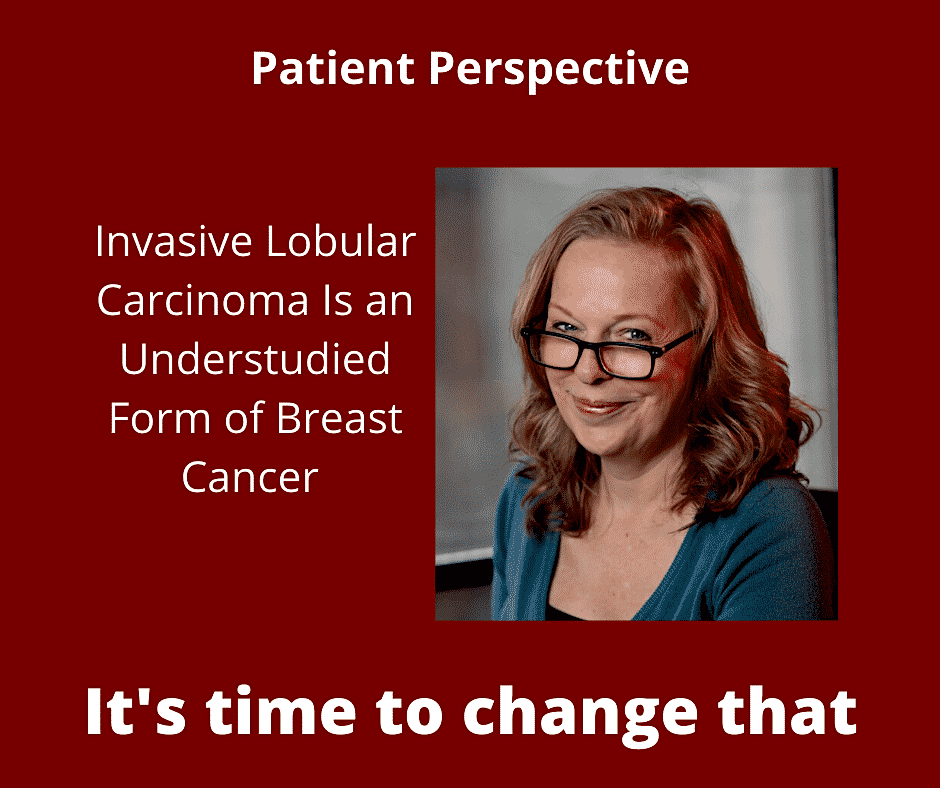Lobular Breast Cancer Alliance (LBCA) research advocate, lobular cancer patient and journalist Diane Mapes shares her story of the challenges of being a patient diagnosed with
You can help spread the word about this sneaky type of breast cancer and advance research to help patients by sharing this article and supporting LBCA’s work to educate and advance research for lobular breast cancer. Contact us about volunteering, and find LBCA on Twitter @LobularBCA and Facebook.
Reprinted from Invasive Lobular Carcinoma Is an Understudied Form of Breast Cancer. It’s Time to Change That by Diane Mapes by permission of Healthline Media, Inc
Invasive Lobular Carcinoma Is an Understudied Form of Breast Cancer. It’s Time to Change That
Hidden, “no lump” lobular is the most common breast cancer you’ve never heard of
You know how mammograms are supposed to help you spot breast cancer early so you have a better chance at survival?
Yeah, I bought into that, too. I dutifully went through those smash-and-screens for years, until early 2011 when I looked in the mirror and noticed a weird little dent just below my left nipple.
That dent turned out to be lobular breast cancer. Stage 3.
And I had four clumps of it, two in each breast. The tumors had been growing slowly and stealthily for years, maybe even as long as I’d been going in for those dang mammograms.
Never heard of lobular? I hadn’t either. But invasive (invisible, more like) lobular carcinoma is the sixth most diagnosed cancer in women. At least, when you break it out from its sister and partner-in-crime invasive ductal carcinoma (IDC).
Lobular breast cancer got lost in the research shuffle years ago
Ductal breast cancer — the kind that makes a lump — accounts for about 80 percent of breast cancers.
Lobular, ILC for short, accounts for around 10 percent — or just 1 in 10 invasive cases.
The numbers are fuzzy because lobular hasn’t really been studied all that much. In a breast cancer paper in the late 1970s, a leading researcher basically said: “Look, women with lobular die at the same rates as women with ductal, so let’s just stick with what we’re doing.”
“There are no special considerations regarding its management,” he wrote. And that was that.
Unfortunately, this particular flavor of breast cancer (there are several) is not the same and shouldn’t be treated the same.
Lobular is notoriously hard to image — in mammography and other scans. As a result, people with lobular are often diagnosed at a later stage, like me.
Every one of my cancer docs called it “sneaky,” saying it’s harder to spot because it doesn’t usually make a lump.
Lobular hiding within already difficult-to-screen dense breast tissue? That’s a double-whammy (which is also how I ended up with my Twitter handle and blog, Double Whammied).
In the 9 years since my treatment, I’ve figured out a lot about lobular, and cancer, in general. I even work at a cancer research center these days, not as a scientist, but a science writer
Interestingly, the place even has some lobular history. Back in 2000, epidemiologists at the Fred Hutchinson Cancer Research Center in Seattle discovered ILC breast cancer rates were on the rise. When they analyzed data from a huge Women’s Health Initiative study, they quickly figured out why.
Women had recently begun using hormone replacement therapy (HRT) to deal with their menopause symptoms. Along with helping curb hot flashes, it also gave a lot of them lobular breast cancer. Strokes, too. And blood clots.
The FDA put the kibosh on the use of HRT and there’s been a raging debate about it ever since.
And lobular? It kind of got lost in the shuffle.
Instead of figuring out how and why a combination of estrogen and progestin would drive this cancer, the powers-that-be decided lobular was already solved. It was just another estrogen receptor positive breast cancer, like ductal. Nothing to see here.
Lobular got lumped in again with its big sister, despite clear molecular differences. And the needle on knowledge again stopped moving.
It’s hard to diagnose and can’t be treated the same as other breast cancers
Here’s the problem. Lobular breast cancer is still commonly diagnosed, even in those who aren’t taking synthetic combined hormone therapy.
And while there are excellent people researching this sneaky little subset (I’m talking to you, University of Pittsburgh), it’s still largely underfunded and understudied.
For many people — including some in white coats — it’s a complete unknown.
Oncologists treat ILC in the exact same way as ductal because both cancers feed on estrogen. But ILC is biologically different. It responds to treatments differently. It spreads differently.
Cells grow in single file, like tree branches or spider webs. Lobular grows in sheaths, almost. Instead of a lump, you’ll feel a thickening in your breast tissue or see a small “tuck” as the skin is tugged from the inside.
Or you might not notice anything at all.
Lobular makes big tumors, it creates multiple tumors, and as with me, it’s more commonly found in both breasts.
There’s one more way this disease is different. When it becomes metastatic (i.e., stage 4), it will show up in the bones and liver just like other breast cancers. But research shows lobular more frequently metastasizes to unusual spots: the ovaries, GI tract, lining of the abdomen, stomach, even the ocular area.
That’s right, breast cancer in your frigging eye. What a creep, right?
Because it’s hard to image — not just with mammography but CT scans and sometimes even PET scans — many metastatic cancers are discovered later, too.
I know lobular patients who’ve recognized their own symptoms of metastatic spread but had doctors doggedly point to clear scans and tell them they were worrying too much. Some of those friends are gone now.
Once your metastatic tumors are large enough to image, it’s often too late to do much about it.
Clinical trials are few and far between
Tragically, the imaging problem also means lobular patients aren’t always eligible for clinical trials. If you can’t see the disease, there’s nothing to measure. Researchers can’t tell if the drug is working or not. They can’t even tell if the patient qualifies for the trial.
As for lobular-specific clinical trials? They’re still few and far between.
I didn’t know any of this stuff when I was first diagnosed. It took a couple of years before I even realized I’d inadvertently joined some super mysterious breast cancer club. But mystery is not what you want when it comes to cancer. You want mundane.
That’s one reason I joined the Lobular Breast Cancer Alliance (LBCA), or “Lob Mob” as I call our group. Founded by a handful of lobular patients and researchers, the LBCA is an all-volunteer advocacy organization trying to raise the profile of ILC in all ways humanly possible.
The aim is two-fold: advance the research and educate the public, patients, primary care physicians — hell, the whole world! — about a common cancer that’s gone under the radar for far too long.
We need to move the needle from neglect to knowledge
It’s time to recognize this cancer as the distinct disease it is and to get the research back on track.
We need better answers as to why this highly hormonal cancer is still showing up in women, particularly in those far too young to use HRT.
We need therapies that are designed specifically for this beast, not its larger, lumpy sister.
We need treatments that target ILC’s unique mutations and make-up, along with imaging that can identify it as soon as possible, in its early stages and in advanced disease.
We need to make sure preventive screening isn’t solely about mammography, but whatever works best for the patient. We need to change policy so preventive screenings are less cookie-cutter and more customized and — hello! — covered by insurance.
We need to move the needle on lobular breast cancer from neglect to knowledge. And then we need to stick it right in the sneaky little bastard’s eye.
###
 Award-winning journalist Diane Mapes writes about cancer for Fred Hutch, a research center in Seattle. After diagnosis and treatment in 2011, she began to write about cancer research and the patient experience for TODAY and other news outlets. Three years later, she started storytelling and “science whispering” for Fred Hutch News. A former contributor at NBCnews, CNN, MSN, Seattle P-I, etc., Mapes has published three books and is currently working on another. Follow her @double_whammied and doublewhammied.com. Mapes is a patient advocate with the Lobular Breast Cancer Alliance.
Award-winning journalist Diane Mapes writes about cancer for Fred Hutch, a research center in Seattle. After diagnosis and treatment in 2011, she began to write about cancer research and the patient experience for TODAY and other news outlets. Three years later, she started storytelling and “science whispering” for Fred Hutch News. A former contributor at NBCnews, CNN, MSN, Seattle P-I, etc., Mapes has published three books and is currently working on another. Follow her @double_whammied and doublewhammied.com. Mapes is a patient advocate with the Lobular Breast Cancer Alliance.

